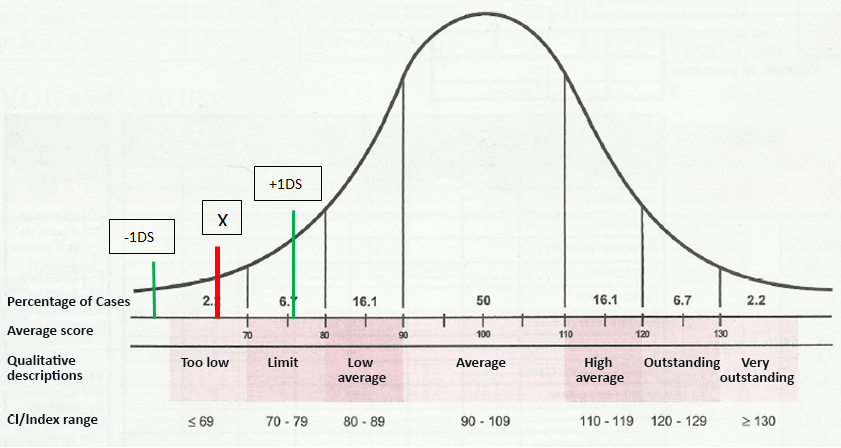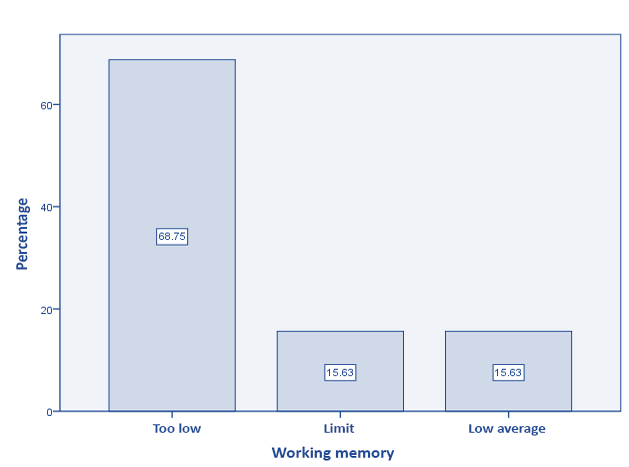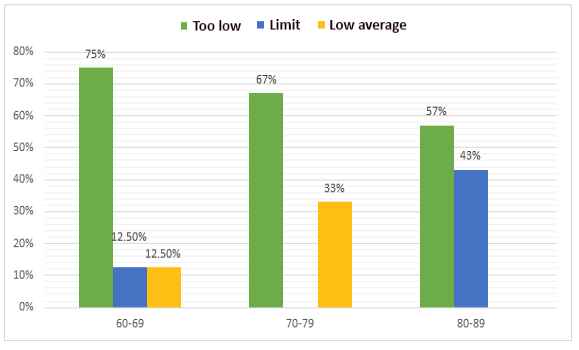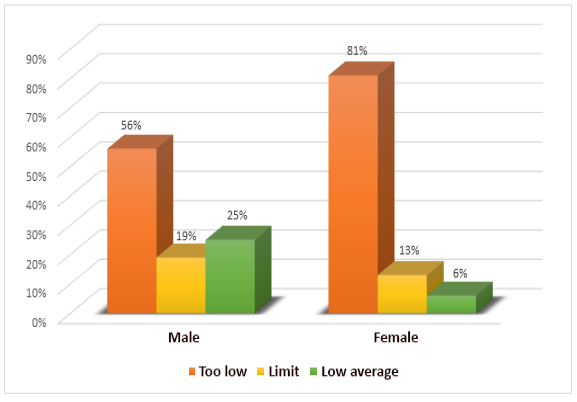ISSN 2410-5708 / e-ISSN 2313-7215
Year 8 | No. 23 | p. 123 - 131 | October 2019 - January 2020
© Copyright (2020). National Autonomous University of Nicaragua, Managua.
This document is under a Creative Commons
Attribution-NonCommercial-NoDerivs 4.0 International licence.
Operation of working memory in users of senior centers
https://doi.org/10.5377/torreon.v8i23.9525
Submitted on January 10th, 2020 / Accepted on January 27th, 2020
MSc. Dustin Ezequiel Amador Jiménez
Professor of the Department of Education and Humanities
UNAN-Managua, FAREM-Carazo
BA. María Elena Lara Sánchez
Graduated from the Psychology degree
UNAN-Managua, FAREM-Carazo
BA. Ligia Walkiria Ortiz Gonzales
Graduated from the Psychology degree
UNAN-Managua, FAREM-Carazo
Keywords: working memory, seniors
SUMMARY
The study aims to assess the level of working memory function in a group of senior centers users from Carazo department during the second half of 2019. Method: The study used a quantitative approach, which allowed the description and establishment of the relationship of the variables under study; a non-experimental, cross-sectional design was used, with a descriptive-correlational scope. The sample consists of 32 adults over the age of 60, both sexes and users of Asylum Agustín Sánchez and La Purísima senior social canteen. The Working Memory Index from the Weschsler Adult Intelligence Scale (WAIS III) was applied, composed by the subtests Arithmetic, Digit retention and Letters and numbers sorting. Descriptive and inferential statistics were used, which allowed the hypothesis contrast to be realized. Results: Results indicate that there are working memory difficulties in participants and presents problems in the ability to manipulate information, have attentional control, planning capacity, organization and temporary and active storage of verbal, visual and spatial information.
Introduction
The main objective of this study is to evaluate the level of functioning of working memory in a group of users of senior centers during the second half of the year 2019, for this, the age and sex of the participants are taken into account. The study was carried out in the Asylum Agustín Sánchez of the city of Jinotepe and the dining room of the elderly La Purísima of the city of Diriamba, in the department of Carazo. These centers are responsible for providing social care to people over 60 years.
The research aims to study the functioning of working memory in elderly subjects. Memory is a cognitive function that allows recording, coding, storing and retrieving previously stored information (Portellano, 2005). Specifically, working memory is a real-time storage system with limited capacity, which allows information to be manipulated by facilitating the fulfillment of several cognitive tasks simultaneously, such as learning, reasoning, understanding, and problem-solving, thanks to the maintenance and temporary availability of data (Baddeley, 1990, in Ostrosky and Flores, 2008), (Ramos, Sopena and Gilboy, 2007).
In old age, there are physical, psychological and social changes that can condition the quality of life of people. Normal aging is associated with a lower performance in the capacity of operational memory and learning, a reduction in the speed of information processing, logical and deductive reasoning, as well as the ability to solve problems (González and Muñoz, 2008), (Ardila and Rosselli, 2007), although these changes do not represent a clinically significant deterioration in the quality of life. However, the accelerated deterioration of functioning in working memory has been associated with cognitive deterioration of diverse etiologies such as abandonment, lack of cognitive stimulation, neurodegenerative disorders, nutritional deficiencies, metabolic alterations or strokes, among others (Ibid.). Therefore, this study has as a hypothesis that there is a deterioration in the functioning of working memory, and this is related to the age and sex of the participants, so it is necessary to study this cognitive function carefully since with this Information The institutions responsible for addressing this type of problem may design therapeutic plans to reduce cognitive impairment based on scientific evidence.
Method
Type of study: The study is applied research, we used a quantitative approach, which allowed us to describe and establish the relationship of the variables under study; we used a non-experimental design, of cross-section, with a descriptive-correlational scope. Participants: The sample is composed of 32 adult subjects of both sexes (16 males and 16 females) who use Asilo Agustín Sánchez and the La Purísima senior social canteen. The sampling is non-probabilistic or directed since the choice of participants does not depend on probability but the characteristics of the research. Instruments: The Working Memory Index was applied (Weschsler Adult Intelligence Scale, WAIS-III), composed of the subtests of Arithmetic, Retention of Digits and Ordering of Letters and Numbers. Procedure: Descriptive statistical procedures were used to analyze the data obtained as measures of central tendency and frequency distribution. To perform the hypothesis test and establish the level of the statistical relationship between the variables, inferential statistics were used, with the non-parametric Chi-square (X2) tests and the Fisher exact test, in which a 95% confidence level was assumed (α ≤ 0.05).
Results
Working memory: According to Ardila and Rosselli (2007), working memory is affected by aging. As this function decreases, the ability to store, monitor and manipulate information while performing a cognitive task in real-time is limited, more time and more rehearsals are needed to learn and solve everyday problems. When the impairment of this function is clinically significant, it can be an indicator of dementia and lead to disability. Table 1 shows the results for this variable.
Table 1. Working memory index
|
Descriptive statistics |
|||||
|
N |
Minimum |
Maximum |
Mean |
Standard Deviation |
|
|
Working memory index |
32 |
50 |
85 |
64,78 |
11,373 |
|
Valid N (per list) |
32 |
||||
When applying the subtests to obtain the Working Memory Index, participants obtained an arithmetic mean (X) of 64.78 and a standard deviation (SD) of 11.3. These scores indicate that most subjects obtained standard scores between 53.48 (-1DS) and 76.08 (+1DS) units. As can be seen in Figure 1, the arithmetic mean of the normal distribution of the WAIS III scale is 100 points with a standard deviation of 10 units, so the mean of the participating subjects is 3 standard deviations below the average of scores obtained by most subjects in the same age ranges.

Figure 1. Working memory.
On the other hand, the operating levels of the working memory can be seen in Figure 2.

Figure 2. Working memory level.
It can be observed that 68.75% of the study subjects have a very low level of functioning of this cognitive capacity, 15.63% of the sample is in the limit category and 15.63% in the low average. The results indicate that there is a deterioration of working memory in most participants and present problems in the calculation, concentration, learning and logical reasoning.
Working memory and age: advanced age has been consistently associated with the deterioration of working memory performance. In Figure 3 it can be seen that 75% of the participants between the ages of 60-69 years have a very low working memory performance, 12.50% have low average performance and 12.50% are in the limit category. On the other hand, among participants aged 70-79, 67% have a very low working memory performance and the remaining 33% have a low average level of functioning.
Finally, 57% of subjects between 80-89 years have very low functioning in this cognitive capacity, while 43% of this age group has a functioning limit.

Figure 3. Working memory and age
Table 2 shows the level of statistical relationship that exists between working memory and the age of the participants.
Table 2. Working memory and age
|
Value |
gl |
Asymptotic sig (bilateral) |
Exact sig (bilateral) |
|
|
Pearson’s Chi-square |
8.062a |
4 |
.089 |
.094 |
|
Likelihood ratio |
9.055 |
4 |
.060 |
.091 |
|
Fisher exact statistic |
6.378 |
.124 |
||
|
Nº of valid cases |
32 |
In the Pearson Chi-square test, X2 = 8.062, gl = 4 and α = 0.089 were obtained, while in Fisher’s exact test it reflects F = 6.378, α = 0.124, in both cases the level of significance is greater than 0.05 Therefore, there is no statistically significant relationship between working memory and age of the participants.
Working memory and sex: Figure 4 shows the working level of working memory according to sex, 56% of male subjects have a very low level of functioning, 19% have a limit level of functioning and 25% within the low average category. On the other hand, 81% of the female sex has a very low level of functioning, 13% a limit level and another 6% a low average level.

Figure 4. working memory and sex
The level of functioning for both female and male sex is within the very low category, which indicates that both sexes have problems in working memory which makes use of immediate memory, attention, perception, and concentration.
Table 3 shows the level of statistical relationship that exists between working memory and the sex of the participants.
Table 3. Working memory and sex
|
Value |
gl |
Asymptotic sig (bilateral) |
Exact sig (bilateral) |
|
|
Pearson’s Chi-square |
2.727a |
2 |
.256 |
.335 |
|
Likelihood ratio |
2.860 |
2 |
.239 |
.335 |
|
Fisher exact statistic |
2.623 |
.335 |
||
|
Nº of valid cases |
32 |
As for the Chi-square test, X2 = 2,727, gl = 2 and α = 0.335 were obtained, while Fisher’s exact test reflects F = 2,623 and α = 0.335. Again, the level of significance is greater than 0.05, therefore, there is no statistically significant relationship between working memory and the sex of the participants, both sexes have significant difficulties regarding this cognitive ability.
Discussion
The results of the study indicate that there is a deterioration of working memory in study participants, which means that they have very little capacity to manipulate information, have attentional control, planning capacity, organization, temporary and active storage of verbal information, visual and spatial.
During the course of the action, the subject needs to have a mental representation of both the objective and the relevant information, not only about the current state but also concerning the future situation (Herreras, 2007), the deterioration of the memory of work makes information processing difficult, resulting in poor performance in cognitive tasks and non-automated actions.
Working memory is a system formed by three elements: the central executive system, the phonological loop and the viso space agenda (Tirapu, Muñoz, and Pelegrín, 2002).
The central executive, who coordinates the activities of two subordinate systems, deals with the attentional and strategic aspects, and his mission would be to control, coordinate and supervise the activities carried out by the cognitive system. It is considered a nuclear element because it governs memory systems (Ostrosky and Lozano, 2011). Another element is the phonological loop, which is responsible for keeping verbal information online through articulatory repetition; This system processes and retains the oral information for one or two seconds, and a subvocal repetition mechanism, which strengthens the footprint of the information contained in the warehouse. Thus, the time of permanence of the information in the working memory is lengthened and its decay is avoided; Besides, the articulation review process participates in the transformation of non-phonological codes into phonological codes, which is necessary for registration in the loop (ibid.). The working memory also includes a spatial viso agenda, this component is responsible for developing and manipulating visual and spatial information, involved in spatial aptitude and in tasks that involve spatial memory (ibid.).
The deficit in the capacity of working memory is disseminated in the three elements that make up the system (Tirapu, Muñoz, and Pelegrín, 2002). In the central executive, there are difficulties in managing the attention and strategies of control, coordination and supervision of the activities carried out by the cognitive memory system. For example, there are difficulties in managing attentional resources when two or more simultaneous tasks are performed and accessing information stored in long-term memory, selecting the appropriate evocation and recall strategies. As for the phonological loop, deficiencies manifest themselves in difficulties of processing and retaining oral information for a few seconds. The time of permanence of the information in the working memory is shortened and its decay occurs. Finally, in the space viso agenda, the deficiencies appear in the lack of capacity to elaborate and manipulate visual and spatial information, involved in the performance of perceptual-motor tasks.
In general terms, interference in working memory translates into worse performance in the tasks of reasoning and ineptitude in solving complex problems, therefore, difficulties arise when learning new behaviors.
One of the main explanations of memory alterations is related to attentional inhibitory control difficulties in working memory processes (Hasher et al., 1999). Aging would be characterized by the presence of irrelevant information and a lack of self-control of working memory processes. The lack of cognitive inhibitory control would congest the capacity of memory, decreasing its effectiveness to store and manipulate new information actively and in real-time, in addition to increasing interference in the process of information evocation.
Finally, it is necessary to emphasize that, in neurobiological terms, the frontal lobe and specifically, the lateral dorsal prefrontal cortex is the brain region most involved in working memory. Prefrontal lesions, especially those in the lateral dorsal region, affect the normal functioning of working memory, which compromises the integrity of cognitive processes (Herreras, 2007), therefore, the results of the study are indicators of cognitive impairment and Possible presence of neuroanatomic and / or neurophysiological alterations in the prefrontal cortex of the participants with serious alterations in the functioning of working memory.
Regarding the level of functioning of working memory and its relationship with age, the low level predominates in all groups. Although statistically no significant relationship was found, at a descriptive level it can be seen that subjects between 60 and 69 years have a greater deterioration in working memory compared to participants between 80 and 80. This result contradicts the results of various Research (Portellano and García, 2015) that indicate the relationship between memory impairment and advanced ages, this could be explained due to various factors such as frequency of educational level, intellectual activity, social interaction, nutrition and presence of medical diseases. Given these results, it is advisable to make a comparison with middle-aged people.
Regarding the level of functioning of working memory and sex, there is no statistically significant relationship between the variables, however, at the descriptive level, it is observed that women have a higher level of deterioration in working memory, which coincides with studies that suggest the existence of differences in this cognitive capacity, which are attributed preliminary to hormonal differences (Nastayashchada and López, 2015).
Conclusions
The results indicate that there is a deterioration of the working memory in the participants and present difficulties in the ability to manipulate the information, have attention control, planning capacity, organization, temporary storage, and manipulation of verbal, visual and spatial information.
In addressing the working memory performance levels, it was found that most of the participants in this study have a very low level, which is an indicator of significant cognitive impairment, which has an impact on the quality of life of people.
Regarding the functioning of working memory, age and sex, no statistically significant relationship was found between the variables in question, both sexes have significant difficulties concerning this cognitive ability.
Works Cited
Ardila, A., y Rosselli, M. (2007). Neuropsicología Clínica. México: Editorial El Manual Moderno.
González, B., y Muñoz, E. (2008). Estimulación de la memoria en personas mayores. Madrid: Editorial Síntesis, S.A.
Hasher, L., Zacks, R., y Rahhal, T. (1999). Timing instructions, and inhibitory control: some missing factors in the age and memory debate. Gerontology, 45. 355-357.
Herreras, E. (2007). Función ejecutiva: evaluación y rehebilitación neurológica. Revista de Educación, 21 (9), 291-300.
Nastayashchada, E., y López, L. (2015). Diferencia entre hombres y mujeres en memoria de trabajo. Revista Neuropsicología, Neuropsiquiatría y Neurociencias, 15 (2), 35-51.
Ostrosky, F., y Lozano, A. (2011). Desarrollo de las funciones ejecutivas y la corteza prefrontal. Revista Neuropsicología, Neuropsiquiatría y Neurociencias, 11 (1), 159-172.
Portellano, J. (2005). Introducción a la Neuropsicología. Madrid: Editorial McGraw-Hill.
Portellano, J., y García, J. (2015). Neuropsicología de la atención, las funciones ejecutivas y la memoria. Madrid: Editorial Síntesis, S.A.
Ramos, P., Sopena, J., y Gilboy, E. (2007). Memoria de trabajo, atención y composicionalidad. Anuario de Psicología, 38 (1), 93-116.
Tirapu, J., Muñoz, J., & Pelegrín, C. (2002). Funciones ejecutivas: necesidad de una integración conceptual. Revista de Neurología, 34 (7), 673-685.